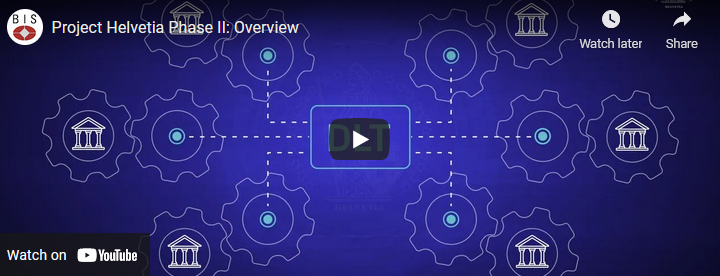In Switzerland, Phase II of Project Helvetia has been completed, successfully demonstrating that it is possible to integrate a wholesale CBDC (wCBDC) running on a distributed ledger technology (DLT) platforms into existing core banking systems.
Kickstarted in 2020, Project Helvetia is an experimental initiative by the Bank for International Settlements (BIS) Innovation Hub Swiss Centre, the Swiss National Bank (SNB) and financial infrastructure operator SIX that focuses on exploring central bank digital currencies (CBDCs).
Phase I, completed in late 2020, showed that a Swiss franc wCBDC could be issued and transferred under Swiss law on a near-live DLT test platform, in this case, the SIX Digital Exchange (SDX).
Phase II, the last part of the project, expanded the experimentation to add commercial banks and integrated wCBDC into their core banking systems and that of the central bank to run transactions from end to end.
The tests covered a wide-range of transactions in Swiss francs, including interbank and monetary policy, and successfully supported the settlement of international transactions.
The transactions ran through test systems of SDX, the Swiss real-time gross settlement system – SIX Interbank Clearing (SIC) – and core banking systems of five banks, namely Citi, Credit Suisse, Goldman Sachs, Hypothekarbank Lenzburg and UBS.
In a report released on January 13, 2022, the organizations detail findings from the experiment, noting that while it is complex but feasible to establish interoperability between DLT-based and traditional systems, it also raises a series of considerations for both central banks and commercial banks, covering, among other things, the specification of interfaces, messaging standards, booking and reconciliation procedures.
Public and private law questions were also raised, especially when wCBDC are issued on a third-party DLT platform and when delegating tasks related to wCBDC to the operator of the infrastructure, the paper says.
In addition to these immediate considerations, a transition towards a tokenized financial ecosystem could introduce broader issues.
For one, increased market activity and a booming tokenization ecosystem could lead to a surge in the number of platforms and settlement assets, increasing choice and competition, and ultimately, introducing greater fragmentation. Hence, exploration of interoperability between DLT-based and traditional systems is crucial at this stage, the paper reads.
Liquidity management challenges also exit. Instant gross settlement, a mechanism often implemented on tokenized asset platforms, requires prefunding of the asset leg and the cash leg. This could alter market structures and require significant amount of liquidity for settlement, potentially fragmenting the supply of liquidity, it says.
Commenting on the completion of Phase II Project Helvetia, Richard Turrin, a best-selling author and top fintech influencer, wrote in a LinkedIn post:
“Many still see blockchain, tokenization, CBDCs as tech for a distant future … Project Helvetia shows how a tokenized wholesale CBDC is not a ‘pipedream’ but a real system … The future isn’t 10 years off, it’s now.”
He added that while the SNB has made it clear that Project Helvetia was “purely experimental,” stating previously that there was no need for a digital Swiss franc at the moment since “the current payment system works well,” Turrin said he “doubts the SNB’s time and effort will be wasted.”
The completion of Project Helvetia followed the successful conclusion of Project Jura, an initiative that sought to explore the direct transfer of euro and Swiss franc wCBDCs between French and Swiss commercial banks on a single DLT platform operated by a third party.
Project Jura involved the SNB, Banque de France, and the BIS Innovation Hub, and was conducted in collaboration with a group of private sector firms comprising Accenture, Credit Suisse, Natixis, R3, SIX Digital Exchange and UBS.
This week, the BIS Innovation Hub unveiled its work program for 2022, among which an upcoming initiative called Project Titus which will be led by the organization’s Swiss hub. No further details have been released at this stage.
Another project being led by the Swiss center is Project Rio, which seeks to develop a prototype of a central bank-specific, real-time capable market monitoring platform.
The post Project Helvetia Successfully Integrates DLT-Backed Wholesale CBDC Into Existing Core Banking Systems appeared first on Fintech Schweiz Digital Finance News – FintechNewsCH.
]]>
Full story here Are you the author? Previous post See more for Next postTags: Featured,newsletter




















